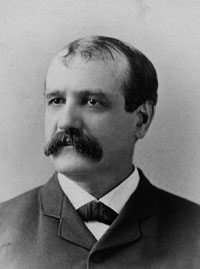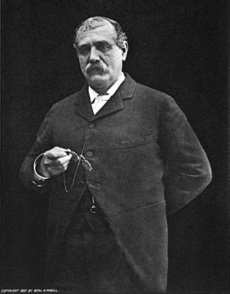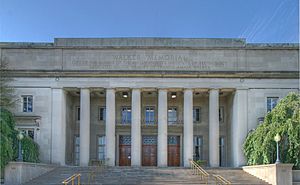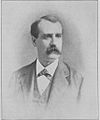Francis Amasa Walker facts for kids
Quick facts for kids
Francis Amasa Walker
|
|
|---|---|

Francis Amasa Walker
|
|
| Born | July 2, 1840 |
| Died | January 5, 1897 (aged 56) Boston, Massachusetts
|
| Resting place | Walnut Grove cemetery, North Brookfield, Massachusetts |
| Education | Bachelor of Laws |
| Alma mater | Amherst College |
| Occupation | Economist Statistician Civil servant Military officer University president |
| Known for | President of MIT (1881–1897) Superintendent of the 1870 and 1880 censuses Commissioner of Indian Affairs (1871–1872) |
| Board member of | American Statistical Association American Economic Association |
| Spouse(s) | Exene Evelyn Stoughton |
| Children | Stoughton (1866–), Lucy (1867–), Francis (1870–), Ambrose (1870–), Eveline (1875–), Everett (1876–), Stuart (1878–) |
| Parent(s) | Hanna Ambrose (1803–1875) and Amasa Walker (1799–1879) |
| Military career | |
| Allegiance | United States of America Union |
| Service/ |
Union Army |
| Rank | |
| Battles/wars | American Civil War |
| 3rd President of the Massachusetts Institute of Technology | |
| In office 1881–1897 |
|
| Preceded by | John Daniel Runkle |
| Succeeded by | James Crafts |
| Commissioner of the Bureau of Indian Affairs | |
| In office 1871–1872 |
|
| President | Ulysses S. Grant |
| Preceded by | Ely S. Parker |
| Succeeded by | Edward Parmelee Smith |
| Signature | |
Francis Amasa Walker (July 2, 1840 – January 5, 1897) was an important American figure. He was an economist (someone who studies how money and resources are made and used), a statistician (someone who collects and analyzes numbers), a journalist, and an educator. He also served as an officer in the Union Army during the American Civil War.
Walker is best known for leading the Massachusetts Institute of Technology (MIT) as its president. He also managed the U.S. national counts of people (called censuses) in 1870 and 1880. His work helped shape how we understand economics and statistics today.
Contents
Early Life and Education
Francis Amasa Walker was born in Boston, Massachusetts, in 1840. He was the youngest son of Amasa Walker, who was also a well-known economist and politician. The family moved to North Brookfield, Massachusetts, in 1843.
Francis started school at age seven. He studied Latin and Greek at various schools. At age fifteen, he entered Amherst College. He was a very bright student and graduated in 1860 with a law degree. After college, he worked at a law firm in Worcester, Massachusetts.
Military Service in the Civil War
When tensions grew between the North and South, Walker wanted to join the war effort. His father was hesitant at first. After the First Battle of Bull Run in July 1861, Walker got his father's permission.
He joined the 15th Massachusetts Infantry. He quickly became an assistant adjutant general (an officer who helps with administrative tasks).
Fighting for the Union
Walker fought in several major battles and campaigns. These included the Peninsula Campaign and the Battle of Williamsburg. He also served in the Army of the Potomac.
In May 1863, at the Battle of Chancellorsville, Walker was badly wounded. An exploding shell injured his hand, wrist, and neck. He couldn't return to duty until August 1863.
Later, during the Richmond-Petersburg Campaign, Walker was captured by Confederate forces. He was held at the famous Libby Prison in Richmond, Virginia. In October 1864, he was released as part of a prisoner exchange.
Becoming a Brigadier General
Walker resigned from the army in January 1865 due to his injuries. After the war, he was honored for his brave service. In July 1866, President Andrew Johnson nominated him for the honorary rank of brevet brigadier general. This means he was given the rank for his outstanding service, even though he wasn't actively commanding troops at that level. The United States Senate confirmed this honor.
Walker later wrote two books about his military experiences. One was about the history of the II Corps and the other was a biography of General Winfield Scott Hancock.
Working for the Government
After the war, Walker worked as a journalist for the Springfield Republican newspaper. He wrote about important topics like politics and railroads.
Leading the U.S. Census
In 1869, Walker was appointed chief of the U.S. Bureau of Statistics. Soon after, he became the superintendent of the 1870 census. This was a huge job, especially since it was the first census after the Civil War. It was also the first time African Americans were fully counted.
Walker faced many challenges, including a lack of control over the people collecting the data. Despite this, he published an amazing Statistical Atlas of the United States. This atlas was special because it used visuals and maps to show the census data for the first time. It earned him international praise.
He also led the 1880 census. This census was even bigger, resulting in twenty-two volumes of data. This work made Walker known as the top statistician in the country. He pushed for a permanent Census Bureau to ensure better data collection and sharing.
Commissioner of Indian Affairs
In 1871, Walker became the U.S. Commissioner of Indian Affairs. He was frustrated by how Native Americans were treated. He resigned after just one year to take a teaching job at Yale.
During his time, he gathered information on native tribes and their history. He published this in a book called The Indian Question in 1874. He suggested that Native Americans should be protected on reservations. This would allow them to gradually become citizens while keeping their culture. He believed that the U.S. should treat Native Americans fairly and with mercy.
Academic and Economic Contributions
In 1872, Walker became a professor of political economy at Yale University's Sheffield Scientific School. He also taught at Johns Hopkins University and Harvard University.
He was elected as an honorary member of the Royal Statistical Society and the National Academy of Sciences. He also served as the first president of the American Economic Association.
Economic Ideas
Walker made important contributions to economic theory. He challenged the idea of the "wage-fund doctrine," which was a belief about how wages were determined. He also debated with economist Henry George about land, rent, and taxes.
Walker supported bimetallism, which is a money system using both gold and silver. He believed it could help prevent economic problems. He wrote a book called International Bimetallism in 1896.
Views on Immigration
Later in his career, Walker became interested in population studies, especially immigration. He wrote articles arguing for stricter limits on immigration. He believed that recent immigrants from certain parts of Europe were "degraded" and "represented the worst failures."
Historians note that Walker's ideas were based on a belief that America had a "natural character" that shouldn't change. These views were very problematic and helped shape the nativist movement in America. His ideas are now seen as bigoted and appalling.
Leading MIT
In 1881, Walker accepted the presidency of the Massachusetts Institute of Technology (MIT). He held this position for fifteen years until his death. MIT was facing financial difficulties at the time.
Growth and New Programs
Walker worked hard to improve MIT's financial situation. He raised money and secured grants from the Massachusetts government. During his time, MIT's campus expanded, and the number of faculty and students grew a lot. Student enrollment quadrupled from 302 to 1,198 students.
He also started many new academic programs. These included Electrical Engineering (1882), Chemical Engineering (1888), and Naval Architecture (1893).
Improving Student Life
Walker cared about student life. He supported building a gymnasium and dormitories. He also helped create the Technology Club, which brought students together.
He made changes to make student life better, like reducing the time spent on homework and limiting exam lengths. He also started summer classes and new graduate degree programs.
Personal Life and Death
Walker married Exene Evelyn Stoughton in 1865. They had five sons and two daughters. He loved watching college football and baseball.
Francis Amasa Walker died on January 5, 1897, from a stroke. He was buried in North Brookfield, Massachusetts.
Legacy
After Walker's death, students and alumni raised money for a memorial. The Walker Memorial Hall was dedicated to him in 1916. It was a clubhouse for students.
From 1947 to 1982, the American Economic Association gave out the "Francis A. Walker Medal." This award recognized economists for their lifetime achievements. It was stopped after the Nobel Memorial Prize in Economic Sciences was created.
However, in recent years, attention has been brought to Walker's very problematic views on race and immigration. A bronze bust of him was moved to the MIT Museum. It is now displayed with a description that calls his views "appalling."
Principal works
- The Indian Question (1874)
- The Wages Question: A treatise on Wages and the Wages Class (1876)
- Money (1878)
- Money in its Relation to Trade and Industry (1879)
- Political Economy (first edition, 1883)
- Land and its Rent (1883)
- History of the Second Army Corps (1886)
- Life of General Hancock (1894)
- The Making of the Nation (1895)
- International Bimetallism (1896)
Images for kids
-
Walker as a Professor of Political Economy at the Sheffield Scientific School
-
A bust of Walker separated from its pedestal at the MIT Museum.
See also
- List of American Civil War brevet generals (Union)
- List of Massachusetts generals in the American Civil War









